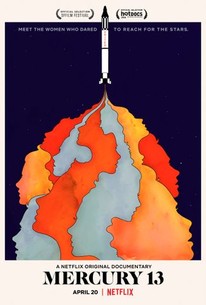Mercury 13 (2017)
(2017)
The "space race" began on October 4, 1957 when the Soviet Union launched Sputnik 1, the first artificial satellite, which orbited the earth for three weeks. The United States began its own manned space program called Project Mercury in 1958. The head of NASA's space medicine was a flight surgeon named Randy Lovelace, who was interested in how women would do in the qualifying tests and exams that were given to the male astronauts. This "Netflix Original Documentary" honors the 13 women who passed Lovelace's privately funded program in 1960 that was not part of NASA. These women never flew in space, or even met as a group. They were given the Phase 1 physical tests, but not Phases 2 and 3. Some of the women later lobbied Congress on behalf of women astronauts. Clare Booth Luce published an article in Life Magazine (June 28, 1963) that criticized the men-only policies, and included the names and photographs of Lovelace's Mercury 13 finalists, making them public for the first time. This is a story of prejudice and lost opportunities, but also progress. The first six women selected for NASA's astronaut program were in 1978. In 1983, Sally Ride became the first American woman in space, 25 years after the Soviets put Valentina Tereshkova in space in 1963. In 1995 Eileen Collins was the first woman to pilot the Space Shuttle, and at the launch she invited and then gave a VIP recognition to the Mercury 13.


